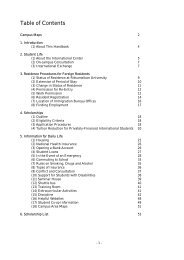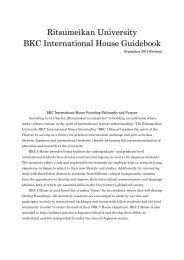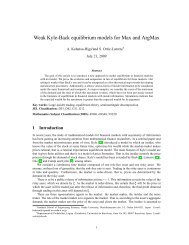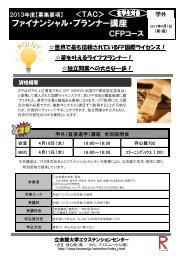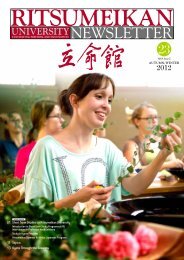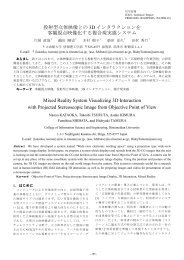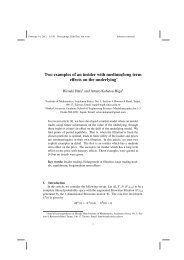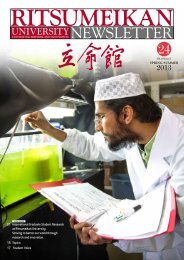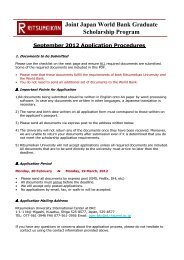Powering the Future - 立命館大学
Powering the Future - 立命館大学
Powering the Future - 立命館大学
You also want an ePaper? Increase the reach of your titles
YUMPU automatically turns print PDFs into web optimized ePapers that Google loves.
Ritsumeikan University College of Pharmaceutical Sciences<br />
Research/Development Areas<br />
Functional Analysis of Human Genomics<br />
Professor / Tetsuya INAZU<br />
We are analyzing genome structures and information (full<br />
genetic information) of patients and studying why those<br />
abnormalities can result in diseases. We hope to eventually<br />
discover treatments, including new drugs, and help prevent<br />
diseases. More specifically we are studying urate metabolism<br />
and congenital metabolic disorders, progeria, mental<br />
retardation, among o<strong>the</strong>rs. We plan to handle everything from<br />
molecules to cells, and individuals and populations as subject<br />
material.<br />
Research/Development Areas<br />
Investigation of <strong>the</strong> ON-OFF Visual<br />
Transmission Pathways in Retinal Circuits<br />
Governing Visual Behavioral Responses<br />
Associate Professor / Chieko KOIKE<br />
We depend on visual information for many of our recognitions<br />
and behaviors in our daily life. Retina is <strong>the</strong> only nervous tissue<br />
that converts optical information into neural information. While it<br />
is well-known that information on visual perception is processed<br />
in <strong>the</strong> cortical visual area, retina is also responsible for basic<br />
and important processing. This laboratory tries to elucidate <strong>the</strong><br />
visual response control by retinal circuit by analyzing <strong>the</strong> ON/<br />
OFF circuit which is <strong>the</strong> core of retinal information processing<br />
using bioengineering techniques.<br />
■human chromosomes<br />
■Colocalization of TRPM1 (red) and mGluR6 (green) in<br />
<strong>the</strong> mouse retina<br />
Research/Development Areas<br />
Signal Transduction Pathways and Drug<br />
Discovery<br />
Research/Development Areas<br />
Mechanism of Germ Cell Differentiation<br />
Professor / Kenji SUZUKI, Assistant Professor / Takako KAWANO<br />
Multicellular organisms control and adjust various physiological<br />
functions through information exchanged between cells. While<br />
<strong>the</strong> information or stimulation transmitted by hormones and<br />
neurotransmitters can result in various responses (proliferation,<br />
differentiation, modulation of cellular functions etc) via cell surface<br />
receptors, many intracellular proteins are also known to<br />
play important roles in <strong>the</strong> process. We are attempting to elucidate<br />
<strong>the</strong> network of signaling molecules (“signal transduction<br />
pathway”) related to <strong>the</strong> onset of diseases such as obesity and<br />
diabetes at <strong>the</strong> molecular level using genetic engineering techniques<br />
and thus contribute to <strong>the</strong> development of new drugs<br />
for use in fighting diseases.<br />
Professor / Tatsuyuki TAKADA<br />
Germ cells (ovum and sperm cells), unlike somatic cells that<br />
make up our bodies, are specialized for <strong>the</strong> purpose of mixing<br />
genetic information and passing it to <strong>the</strong> next generation. Germ<br />
cell lineage is established at an early stage of development, via<br />
a special type of cell division known as meiosis, which differs<br />
from that of somatic cells. Genetic diversity was established in<br />
this process through random assortment of chromosomes and<br />
recombination, and newly formed genetic information was<br />
transmitted to a new generation through sexual reproduction.<br />
We are studying lineage decision of germ cell and its differentiation<br />
mechanism with primary emphasis on gene expression and<br />
DNA methylation using mouse and monkey ES cells. Recent<br />
study include elucidation of <strong>the</strong> mechanism of environmental<br />
chemicals on cell differentiation using ES cells, as well as establishment<br />
of cell line on endemic species in Lake Biwa.<br />
■microscopic analysis of cell lines<br />
■Embryoid body (left) and expression of germ cell marker (green,<br />
right)<br />
59 Ritsumeikan University <strong>Powering</strong> <strong>the</strong> <strong>Future</strong>



